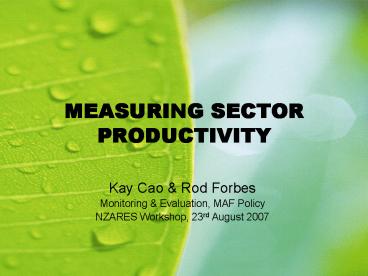Kay Cao - PowerPoint PPT Presentation
1 / 17
Title:
Kay Cao
Description:
Productivity measurement works with Statistics NZ and Massey University; ... (Statistics NZ data) and Malmquist (Massey's project using MAF's Farm Monitoring data) ... – PowerPoint PPT presentation
Number of Views:28
Avg rating:3.0/5.0
Title: Kay Cao
1
MEASURING SECTOR PRODUCTIVITY
- Kay Cao Rod Forbes
- Monitoring Evaluation, MAF Policy
- NZARES Workshop, 23rd August 2007
2
Purpose Outline
- Purposes
- What MAFs doing and future research
- Discussion of an alternative method.
- Outline
- Background
- Current results
- Current method and data
- Alternative method (Labour share)
- Results comparison
- Conclusion Future research
3
Background
- MAFs Growth and Productivity project
- Productivity measurement, Trade performance, and
others - Started 06/07, now second year
- Productivity measurement works with Statistics NZ
and Massey University - Currently using 2 methods Index number
(Statistics NZ data) and Malmquist (Masseys
project using MAFs Farm Monitoring data)
4
Some Definitions
- Total Factor Productivity, not partial
productivity - TFP measures production efficiency
- Changes as a result of changes in management
practices and technology - Important source for long term growth
- BUT not a measure for profitability
- TFP contributes to profitability BUT doesnt
incl. price effects - MAFs TFP measures at aggregated industry level
5
Current TFP results
Agriculture, forestry, and downstream sectors TFP
growth (annual average growth rate , 1972-2006)
6
Current data and method
- Data
- Industry aggregate data from Statistics NZ (GDP,
productive capital stock, labour FTEs) - Method
- Tornquist chained index
- Input index aggregated from K and L index
weighted by their shares of total factor income - K share derived by user cost of capital method L
is residual
7
Method cont.
- User cost of capital
- UCC PKScurrentprices (d r)
- Where d is capital depreciation rate, r is rate
of return on capital. - K share UCC/GDPcurrentprices
- L share 1- K share
- Total factor input index
- where wk is K share and wl is L share
8
Alternative method
- Data now available for deriving Labour share
- Advantage
- use available National Account data (incl COE,
GOS, Tax, Subsidy) and proportion of
self-employed - dont have to approximate capital ror and other
data required for K share method - L share (employees wage self-employeds wage
production tax attributed to L)/GDP - K share 1- L share
9
Results of L share method
Agriculture, forestry, and downstream sectors TFP
growth (annual average growth rate , 1988-2006)
10
Results cont.
11
Results cont.
12
Results cont.
13
Results cont.
14
Results cont.
Contribution of TFP, capital, and labour to
sector GDP growth (annual average growth rate ,
1988-2006)
15
Conclusion Future Research
- L share method shows
- Slightly lower TFP estimates
- Higher K contribution
- Lower L contribution
- Advantage of L share method reflects better
factor share as dont have to approx data - K share method underestimate K share as missing
tax component and approx ror - New method only change TFP slightly due to
changes in the weighting components NOT the real
factor growth
16
Future Research
- Qualitative analysis of factors contributing to
sector TFP growth - Modelling determining factors of TFP growth (Op
research contract with Massey Uni) - TFP measurement for sub-sector level using SNZ
aggregate data - TFP measurement for sub-sector level using
Farm-level data and possibly SNZ Longitudinal
Firm Performance Data (LFPD / IBULDD)
17
Comments / Questions
To Kay.Cao_at_maf.govt.nz Or Rod.Forbes_at_maf.govt.nz































